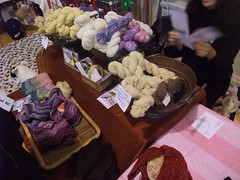
I'm fighting the "woe is me" syndrome this winter by sharpening my DIY skills. High gas prices and a limited winter income have kept me at home more than I'd like these days and I'm shifting my grocery budget to seed buying for the summer.
Every once in a while I crave junk food but my pantry is only stocked with basic staples these days: potatoes, apples, flours, sugar, cooking oils, spices, cocoa, coffee. . . when I have a snack craving I'm forced to make something from scratch. I tried a few cupcake recipes from the Wednesday Tribune food section but they didn't delight.
Today I went for a childhood favorite. Fried dough. I use a basic recipe similar to
krofne but I make up the recipe every time. Today in an attempt at frugality I used just water instead of milk. I simply put some warm tap water in a bowl, added a sprinkle of granular sugar, a packet of yeast and stirred. Then I added flour, without measuring, and kneaded the sticky dough in a bowl on my lap with one hand while I read Facebook updates on the computer. I hate kneading dough, always have.
Instead of cutting out circles in the dough, I rolled it out, cut them into diamonds/rectangles, sliced down the center and pulled one end through the slice. You can see in the picture it gives them a bit of a flourish. I'm sure there's a proper name for these pastries, if you know it please share. I cooked the dough in hot oil, today I had sunflower oil in the pantry so that's what I used. After they browned I put them on paper towels to absorb the extra oil, then placed them in a gallon-sized zippered plastic bag, sprinkled powdered sugar inside, and shook the bag. Now I've got a stash of sweet fried dough to snack on for a couple of days. Great with coffee.
* * *

The coffee I'm drinking now is a
Yakuza special from
Resistance Coffee. I splurged a bit on these locally-roasted beans because the company includes my friend David Meyers, who I met years and years ago when I lived and worked in Wicker Park and he was writing for
Letter X, a Chicago poetry journal. I find it a bit weird that David's been farming within miles of my farm for years. This coffee is a special "Yakuza" blend (I think all the Resistance coffee is the same, they just put a different sticker on the bag) is for one of my favorite bands, fronted by my friend
Bruce Lamont, founder of the
Empty Bottle Farmers Market and longtime
Videnovich Farms supporter. Another way my worlds collide is that the illustration is by
Scott Fricke, a dear friend I met when we studied at the School of the Art Institute of Chicago.
















